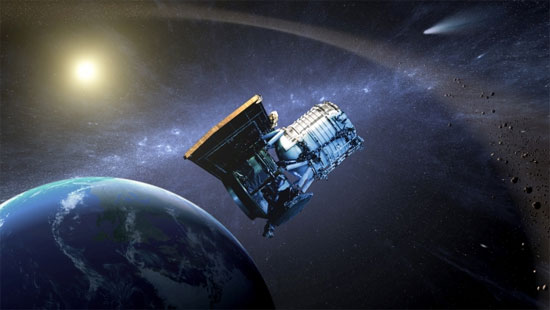NASA re-activates the WISE probe
Wide-field Infrared Survey Explorer (WISE) is an infrared probe spacecraft launched by NASA on December 14, 2009. In February 2011, the ship was taken to a resting regime, ending the task of discovering and exploring more than 10 thousand celestial bodies throughout the solar system. However, today the US aerospace agency announced the re-activation of WISE to begin a new three-year mission since September this year. Accordingly, WISE will hunt for potentially dangerous objects near the Earth while paving the way for future meteorite discovery missions.
Next month, WISE will return to the program to explore and explore features near Earth (NEOs). The object here will be meteorites that orbit within 45 million kilometers of the Earth and around the Sun. NASA expects WISE to use the 40cm telescope and the built-in infrared cameras on the ship to explore about 150 previously unknown NEOs and record information about size, projection and properties. heat of about 2000 other NEO.
John Grunsfeld, NASA's science program link manager in Washington, said: "WISE's mission is complete and NEOWISE has taken the exploration of meteorites further. Now NASA is Expanding the success of NEOWISE to enhance the ability to search for dangerous meteors and support future Asteroid Initiative programs The reactivation of WISE is a good example of how we declare working with the available capabilities to achieve the goal ".

The Asteroid Initiative will be NASA's first mission to detect, explore and redefine a meteorite. The program also represents new technologies, using scientific discoveries and technological capabilities to protect our planet. At the same time, the program will be the convergence of the best human resources, science and technology aiming at bringing people to a meteorite in 2025 initiated by US President Obama.
WISE's main mission in the past was to find the light of heat sources from meteorites, stars and galaxies. During the period from January 2010 to January 2011, WISE sent 7500 images every day. NEOWISE is an expanding mission and the ship's mission is to study in more detail the age of the NEO. After finishing the mission, most of WISE's electronic devices have been turned off by NASA and the ship goes back to sleep mode (hibernate).
"The NEOWISE data collected two years ago was a gold mine to discover and describe meteorites near Earth. It is important that we accumulate as much data as possible when the ship is still priced. treatment , " said Lindley Johnson, NEOWISE program director.
Since reflected light from meteorites is not visible, infrared sensors are the best tool to detect, classify and learn about meteorite networks. Based on the object's reflection of light or the projection rate, a small, light-colored meteorite can be seen as a large, dark meteorite. As a result, data collected with conventional optical telescopes is not really accurate.
During 2010, NEOWISE observed about 158,000 meteors out of 600,000 items recorded. It discovered 21 comets, more than 34,000 meteorites in the main belt between Mars and Jupiter and 135 objects near the Earth.
The first mission of the WISE is to scan a portion of the sky with infrared light. The ship captured 2.7 million images with infrared wavelengths and divided the list to 560 million objects in space from distant galaxies to meteorites and comets near Earth.
Amy Mainzer, researcher on the NEOWISE program at NASA's JPL propulsion systems laboratory in Pasadena, California, said: "The team is ready and after a quick inspection of the ship, we will press the re-activate button NEOWISE not only gives us a better understanding of the meteors and comets that we have studied directly, but also helps us screen mission ideas and plans for the future, porcelain The network studies objects near Earth in space ".
JPL laboratory is responsible for managing WISE program for NASA's scientific mission department. WISE's mission is part of NASA's Explorers program launched and monitored by the Goddard space center. As for the WISE spacecraft, scientific equipment was built by NASA's space dynamics laboratory in Logan, Utah. Meanwhile, the hull and finishing are done by Ball Aerospace & Technologies Corp. Operations and data processing operations are carried out at the infrared processing and analysis center of the California Institute of Technology, Pasadena (Caltech).
- Every day NASA discovers dozens of
- NASA probe set a record of approaching the nearest Sun.
- NASA launches a spacecraft to explore the sun's mystery in 2018
- NASA revealed the mission of the next Mars probe
- NASA delayed the launch of the Moon probe
- NASA's billion-dollar probe began to fall freely into Jupiter
- NASA announces a great mission: Exploring the Sun in a hot 1,400 degree C hot pan
- NASA's Opportunity space probe sets a new record
- The new telescope reveals the stealthy neighbors' stars.
- NASA studies spacecraft with an asteroid explorer
- NEOWISE ships back after starting a new mission
- NASA launched the Mars probe
 Van Allen's belt and evidence that the Apollo 11 mission to the Moon was myth
Van Allen's belt and evidence that the Apollo 11 mission to the Moon was myth The levels of civilization in the universe (Kardashev scale)
The levels of civilization in the universe (Kardashev scale) Today Mars, the sun and the Earth are aligned
Today Mars, the sun and the Earth are aligned The Amazon owner announced a secret plan to build a space base for thousands of people
The Amazon owner announced a secret plan to build a space base for thousands of people